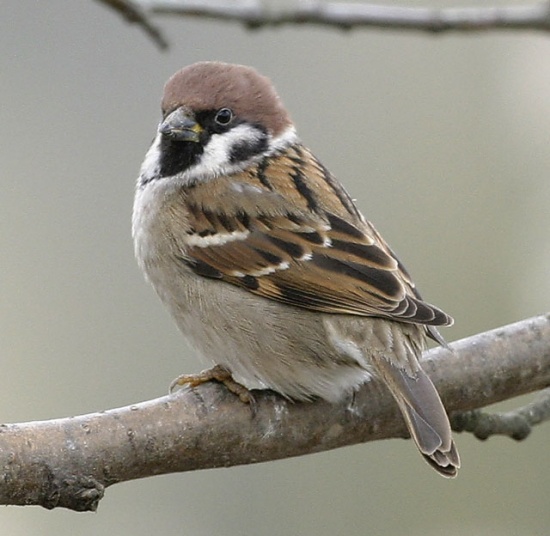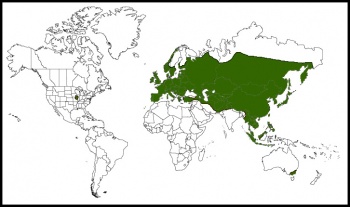Nomdeploom (talk | contribs) m (genus tag addition) |
(Map size adjusted) |
||
| (10 intermediate revisions by 5 users not shown) | |||
| Line 1: | Line 1: | ||
| + | [[Image:Eurasian_Tree_Sparrow.jpg|thumb|550px|right|Photo by {{user|rayh|rayh}}<br />Carsington Water, [[England]], February 2004]] | ||
| + | '''Alternative names: Tree Sparrow; European Tree Sparrow''' | ||
;[[: Category:Passer|Passer]] montanus | ;[[: Category:Passer|Passer]] montanus | ||
| − | |||
| − | |||
==Identification== | ==Identification== | ||
| − | A | + | 14 - 15cm. A small, neat-looking sparrow: |
| + | * Chestnut crown and nape | ||
| + | * White cheeks with a black spot | ||
| + | * Small black bib not expanding on breast | ||
| + | * Narrow white neck-collar | ||
| + | * Black-streaked brown back | ||
| + | * Distinct white wing-bar | ||
| + | * Dusky underparts | ||
| + | Sexes and ages similar.<br /> | ||
| + | The subspecies mainly differ in plumage tones and in size. Those in arid regions tend to be paler (eg. ''dilutus''), those in tropical humid areas darker (eg. ''malaccensis'') | ||
| + | ====Similar Species==== | ||
| + | [[House Sparrow]], which has a grey head and lacks the white cheeks. | ||
==Distribution== | ==Distribution== | ||
| − | Widespread and | + | {| cellpadding="5" |
| − | + | |- | |
| − | Resident or partial migrant over most of range and winter visitor to the larger Mediterranean islands. | + | | rowspan=2 valign="center"| |
| − | + | [[Image:Map-Eurasian Tree Sparrow.jpg|350px|left]] | |
| − | Vagrants recorded in Gibraltar and North-West Africa, Egypt and Israel. | + | |Widespread from [[Europe]] east over [[Russia]] to [[China]] and southeast [[Asia]]. Introduced populations in [[Australia]] and the [[US]] (St. Louis, [[Missouri]]).<br /> |
| − | == | + | In Europe breeds in coastal [[Ireland]] and [[Britain]] (but rather uncommon in the north), and from western [[France]], north and eastern [[Iberia]] east across [[Europe]] to the Urals and Caspian reaching coastal and southern [[Scandinavia]], the [[Baltic States]] and the White Sea. In the south occurs on the Mediterranean coasts of [[Spain]] and [[France]], [[Italy]] and [[Sicily]], the Balkans, patchily in west, central and northern [[Turkey]] and the [[Caucasus]]. Formerly bred in the [[Faroes]] and has bred [[Morocco]], recently in [[Malta]] and Gozo] introduced to [[Sardinia]]. |
| − | + | Rare breeder in the [[Canary Islands]], found only on [[Gran Canaria]].<br /> | |
| + | Resident or partial migrant over most of range and winter visitor to the larger Mediterranean islands. Vagrants recorded in [[Gibraltar]] and North-West [[Africa]], [[Egypt]] and [[Israel]]. | ||
| + | |- | ||
| + | |<font size=4>Legend</font><br /> | ||
| + | '''<font color="#336600" style="background-color: black">•</font>''' ''Passer montanus''; year-round<br /> | ||
| + | <font size="1">Maps/Texts consulted<sup>[[#References|2]]</sup></font> | ||
| + | |} | ||
==Taxonomy== | ==Taxonomy== | ||
| − | Subspecies | + | ====Subspecies<sup>[[#References|[1]]]</sup>==== |
| + | *''P. m. montanus'': [[Europe]] to north [[Africa]], northern [[Mongolia]], Manchuria and Sea of Okhotsk | ||
| + | *''P. m. transcaucasicus'': Southern [[Caucasus]] (Black Sea coast of [[Georgia]] to northern [[Iran]]) | ||
| + | **Generally duller and greyer above, whiter below | ||
| + | *''P. m. dilutus'': Transcaspia to western [[Pakistan]], Gobi Desert and western [[China]] (Xinjiang) | ||
| + | *''P. m. dybowskii'': Eastern [[Asia]] (lower Amur River to Manchuria and northern [[Korea]]) | ||
| + | *''P. m. kansuensis'': Western [[China]] (Zaidam basin and northern Gansu) | ||
| + | *''P. m. iubilaeus'': Eastern [[China]] (Liaoning to lower Yangtze River and Shaanxi) | ||
| + | *''P. m. obscuratus'': [[Nepal]] to north-eastern [[India]], [[Myanmar]] and west-central [[China]] (Sichuan to Hubei) | ||
| + | *''P. m. saturatus'': Southern Kuril Island, [[Japan]], [[South Korea]], Ryukyu Island, [[Taiwan]] and south-eastern [[China]] | ||
| + | *''P. m. malaccensis'': Central [[Myanmar]], [[Malaya]], Hainan, [[Vietnam]] and western [[Indonesia]] | ||
==Habitat== | ==Habitat== | ||
| − | Open woodland and along woodland edges, parkland and farmland with copses and hedgerows. | + | Open woodland and along woodland edges, parkland and farmland with copses and hedgerows. In parts of the range quite frequent in suburbs or even in urban areas. |
| + | |||
==Behaviour== | ==Behaviour== | ||
| − | Secondary cavity nester. Not aggressive or pugnacious like the | + | Highly gregarious, this bird prefers the vicinity of humans. |
| − | + | ====Diet==== | |
| − | == | + | Feeds mainly on seed of herbs, grasses and cereals. Takes also animal food like spiders and insects during breeding season. |
| + | ====Breeding==== | ||
| + | Secondary cavity nester. Not aggressive or pugnacious like the [[House Sparrow]], but may attempt to claim a box used by another bird. | ||
| + | ====Vocalisation==== | ||
<flashmp3>Passer montanus (song).mp3</flashmp3><br /> | <flashmp3>Passer montanus (song).mp3</flashmp3><br /> | ||
''[[Media:Passer montanus (song).mp3|Listen in an external program]]'' | ''[[Media:Passer montanus (song).mp3|Listen in an external program]]'' | ||
| + | ==References== | ||
| + | #{{Ref-Clements6thDec09}}#{{Ref-HBWVol14}} | ||
| + | {{ref}} | ||
==External Links== | ==External Links== | ||
| − | {{GSearch|Passer+montanus}} | + | {{GSearch|Passer+montanus}} |
| − | [[Category:Birds]] [[Category:Passer]] | + | <br /> |
| + | {{Video|Eurasian_Tree_Sparrow}} | ||
| + | [[Category:Birds]] [[Category:Passer]][[Category:Bird Songs]] [[Category:Videos]] [[Category:Maps]] | ||
Revision as of 08:49, 7 February 2011
Alternative names: Tree Sparrow; European Tree Sparrow
- Passer montanus
Identification
14 - 15cm. A small, neat-looking sparrow:
- Chestnut crown and nape
- White cheeks with a black spot
- Small black bib not expanding on breast
- Narrow white neck-collar
- Black-streaked brown back
- Distinct white wing-bar
- Dusky underparts
Sexes and ages similar.
The subspecies mainly differ in plumage tones and in size. Those in arid regions tend to be paler (eg. dilutus), those in tropical humid areas darker (eg. malaccensis)
Similar Species
House Sparrow, which has a grey head and lacks the white cheeks.
Distribution
| Widespread from Europe east over Russia to China and southeast Asia. Introduced populations in Australia and the US (St. Louis, Missouri). In Europe breeds in coastal Ireland and Britain (but rather uncommon in the north), and from western France, north and eastern Iberia east across Europe to the Urals and Caspian reaching coastal and southern Scandinavia, the Baltic States and the White Sea. In the south occurs on the Mediterranean coasts of Spain and France, Italy and Sicily, the Balkans, patchily in west, central and northern Turkey and the Caucasus. Formerly bred in the Faroes and has bred Morocco, recently in Malta and Gozo] introduced to Sardinia.
Rare breeder in the Canary Islands, found only on Gran Canaria. | |
| Legend • Passer montanus; year-round |
Taxonomy
Subspecies[1]
- P. m. montanus: Europe to north Africa, northern Mongolia, Manchuria and Sea of Okhotsk
- P. m. transcaucasicus: Southern Caucasus (Black Sea coast of Georgia to northern Iran)
- Generally duller and greyer above, whiter below
- P. m. dilutus: Transcaspia to western Pakistan, Gobi Desert and western China (Xinjiang)
- P. m. dybowskii: Eastern Asia (lower Amur River to Manchuria and northern Korea)
- P. m. kansuensis: Western China (Zaidam basin and northern Gansu)
- P. m. iubilaeus: Eastern China (Liaoning to lower Yangtze River and Shaanxi)
- P. m. obscuratus: Nepal to north-eastern India, Myanmar and west-central China (Sichuan to Hubei)
- P. m. saturatus: Southern Kuril Island, Japan, South Korea, Ryukyu Island, Taiwan and south-eastern China
- P. m. malaccensis: Central Myanmar, Malaya, Hainan, Vietnam and western Indonesia
Habitat
Open woodland and along woodland edges, parkland and farmland with copses and hedgerows. In parts of the range quite frequent in suburbs or even in urban areas.
Behaviour
Highly gregarious, this bird prefers the vicinity of humans.
Diet
Feeds mainly on seed of herbs, grasses and cereals. Takes also animal food like spiders and insects during breeding season.
Breeding
Secondary cavity nester. Not aggressive or pugnacious like the House Sparrow, but may attempt to claim a box used by another bird.
Vocalisation
<flashmp3>Passer montanus (song).mp3</flashmp3>
Listen in an external program
References
- Clements, JF. 2009. The Clements Checklist of Birds of the World. 6th ed., with updates to December 2009. Ithaca: Cornell Univ. Press. ISBN 978-0801445019.
- Del Hoyo, J, A Elliott, and D Christie, eds. 2009. Handbook of the Birds of the World. Volume 14: Bush-shrikes to Old World Sparrows. Barcelona: Lynx Edicions. ISBN 978-8496553507
Recommended Citation
- BirdForum Opus contributors. (2024) Eurasian Tree Sparrow. In: BirdForum, the forum for wild birds and birding. Retrieved 25 April 2024 from https://www.birdforum.net/opus/Eurasian_Tree_Sparrow
External Links





